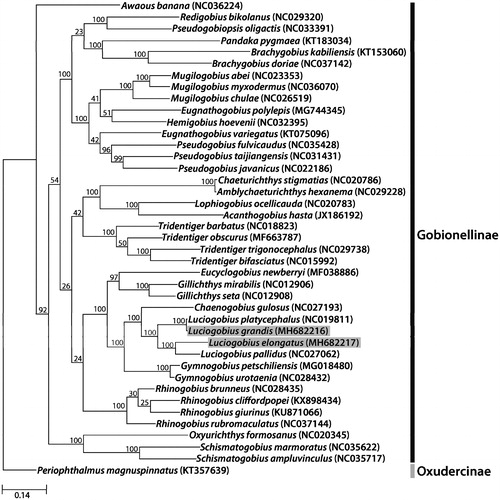Abstract
The complete mitochondrial genomes of Luciogobius grandis and Luciogobius elongatus (Perciformes, Gobionellinae) living on rocky coasts in South Korea are reported here for the first time. The mitogenomes of L. grandis and L. elongatus have total lengths of 16,477 bp and 16,486 bp, respectively, and include 13 PCGs, small and large rRNAs, a control region, and 22 tRNAs. Most of the genes are encoded on the heavy strand except for nine genes. Compared with other Gobionellinae species, the PCGs of the two Luciogobius species have a conserved gene order. These data provide useful molecular information for phylogenetic studies concerning Luciogobius species and related species.
Luciogobius, a genus of the Gobionellinae, comprises 16 species and is mainly distributed in north-eastern Asia (Kanagawa et al. Citation2011). Seven Luciogobius species were reported in Korea (The National Institute of Biological Resources Citation2017), but data are lacking on their biological characteristics and genetic information. In this study, we first determined the complete mitochondrial genomes of the two Luciogobius species, L. grandis and L. elongatus.
The specimens were collected from Jangmok-myeon, Geoje-si, Gyoungsangnam-do on the southern coast of South Korea (deposited in National Institute of Biological Resources, accession numbers SH130607-3B (L. grandis) and SH130607-3A (L. elongatus)). PCR primers based on short fragment sequences of COX1 (Ward et al. Citation2005) were designed to amplify and sequence the complete mitochondrial DNA.
The total lengths of the mitogenomes of L. grandis and L. elongatus were 16,477 bp and 16,486 bp, respectively, with a genome size similar to other gobies. The annotated mitochondrial genome sequences were submitted to GenBank with accession numbers MH682216 (L. grandis) and MH682217 (L. elongatus).
The mitochondrial genome of both species contains large and small rRNAs, 22 tRNAs, a control region, and 13 protein coding genes. The tRNAs and PCGs were predicted using tRNAscan-SE 1.21 (Schattner et al. Citation2005) and ORFfinder (https://www.ncbi.nlm.nih.gov/orffinder/). The A/T contents are 58.2% in L. grandis and 57.8% in L. elongatus. Most genes are encoded on the heavy strand, except for one PCG (ND6) and eight tRNA genes (tRNAPro, tRNAGlu, tRNASer, tRNATyr, tRNACys, tRNAAsn, tRNAAla, and tRNAGln). All the PCG genes start with the orthodox ATG start codon, whereas COX1 gene starts with GTG. A GTG codon has also been reported as a start codon of COX1 gene in other Luciogobius species (Jin et al. Citation2013; Yu et al. Citation2015). In the mitogenome of L. grandis, six PCGs share the termination codon TAA (COX1, ATP8, ATP6, ND4L, ND5, and ND6) and three PCGs have TAG as a termination codon (ND1, ND2, and ND3). In L. elongatus, seven PCGs use TAA as a stop codon (ND1, ND2, COX1, ATP8, ATP6, ND4L, and ND5) and two PCGs have TAA (ND3 and ND6). In both of the two species, four PCGs (COX2, COX3, ND4, and CYTB) have incomplete codon T, which is common among vertebrate mitochondrial protein-coding genes (Ojala et al. 1981). The gene composition and order of L. grandis and L. elongatus were identical to those of other Gobionellinae including the genus Luciogobius (Jin et al. Citation2013; Yu et al. Citation2015). Most of the tRNA genes can be folded into typical cloverleaf secondary structures, except for tRNASer(UGA), which lacks a D arm in the mitogenomes of L. grandis and L. elongatus. The three tRNA clusters (IQM, WANCY, and HSL) are well conserved in the two species as those of typical vertebrate mitogenomes (Jin et al. Citation2013).
The complete mitochondrial genomes of L. grandis and L. elongatus and other Gobionellinae species were used to reconstruct a maximum likelihood tree with 1000 bootstrap replicates (). The phylogenetic analyses were performed using RAxML (v8.2.10) (Stamatakis Citation2014) on CIPRES website.
Figure 1. The molecular phylogenetic tree of the two Lucigobius species and other related species in Gobionellinae based on mitochondrial 13 protein-coding gene sequences. The complete mitochondrial genomes were obtained from GenBank and the accession numbers of the sequences are indicated in parentheses after scientific name of each species. The phylogenetic tree constructed by a maximum-likelihood method with 1,000 bootstrap replicates.

Disclosure statement
No potential conflict of interest was reported by the authors.
Additional information
Funding
References
- Jin X, Sun Y, Zhao S, Wang R. 2013. Mitochondrial genome of the Luciogobius platycephalus (Perciformes, Gobioidei). Mitochondrial DNA. 24(4):379–381.
- Kanagawa N, Itai T, Senou H. 2011. Two new species of freshwater gobies of the genus Luciogobius (Perciformes: Gobiidae) from Japan. Bull Kanagawa Prefect Mus (Nat. Sci.). 40:67–74.
- Schattner P, Brooks AN, Lowe TM. 2005. The tRNAscan-SE, snoscan and snoGPS web servers for the detection of tRNAs and snoRNAs. Nucleic Acids Res. 33:W686–W689.
- Stamatakis A. 2014. RAxML Version 8: a tool for phylogeneitic analysis and post-analysis of large phylogenies. Bioinformatics. 30(9):1312–1313.
- The National Institute of Biological Resources. 2017. National List of Species of Korea. Incheon. NIBR.
- Yu J, Kim B, Kim S, Oh K, Lim CE. 2015. Complete mitochondrial genome of the rare hypogean gobiid, Luciogobius pallidus, from Korea. Mitochondria DNA. 26(1):118–120.
- Ward RD, Zemlak TS, Innes BH, Last PR, Hebert PDN. 2005. DNA barcoding Australia's fish species. Philos Trans R Soc Lond B Biol Sci. 360:1847–1857.
